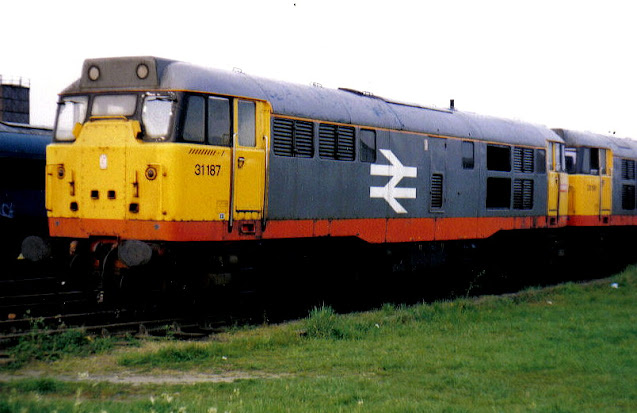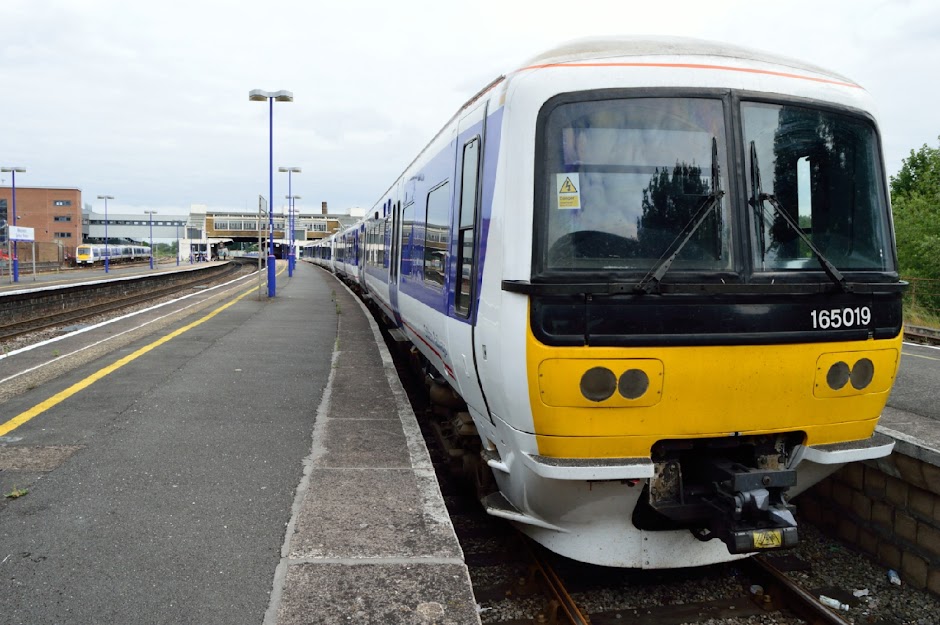Photo Class 31187 Diesel Locomotive Whitemoor Yard |
Photo: Charles MoorhenIn the red, grey and yellow of the British Rail Railfreight livery, Class 31187 diesel locomotive photographed on sidings at Whitemoor rail Yard near March railway station, Cambridgeshire, next to an unidentified loco of the same class and livery in May 1989.
For more detailed information and a variety of images of the Class 31 diesel locomotive, please visit this post elsewhere on this blog - Photos, Article Class 31 Diesel Loco 'A British Rail Workhorse'. Class 31187 (front) hauling a ballast train at Helpston crossing, 1989. Photo: DEAN M66A - flickr. Class 31 Diesel Locomotive Historical Note: Whilst hauling a train in which Queen Elizabeth II was travelling on 4th January 1961, D5667 (31240), broke down south of Cambridge. Two onboard Brush fitters, on hand to deal with any mechanical problems that may occur, were unable to fix the problem and a steam loco had to be sent for in order to rescue the stricken diesel adding over an hour to the completed journey. Class 31 Locomotives on YouTube: Class 31 Video Compilation - 2011 to 2019. Don't forget to subscribe to 'Along These Tracks' railway blog to get all new posts and updates sent directly to you. |
Translate 'Along These Tracks' Railway Photo Blog Posts For Your Chosen Language
'Along These Tracks' Railway Blog Posts
Saturday, 9 May 2020
Photo Class 31187 British Rail UK Diesel Loco Whitemoor Yard 1989
Wednesday, 6 May 2020
Night Photo Empty Leamington Spa UK Train Station 2016
Lit-Up and Lonely  | |
| Photo: Charles Moorhen | |
A long exposure night photo (top) of Leamington Spa railway station, with an unidentified Chiltern Railways diesel multiple unit creeping into the picture on the far right having recently departed from Banbury.
Serving the Warwickshire town of Royal Leamington Spa, UK, the railway station in Old Warwick Road, has been a constant presence in the town since it was opened by the Great Western Railway in 1852 - rebuilt in 1939.
In March 2008, the railway station booking hall was refurbished and now reflects the original GWR art-deco style.
Large 'running in' boards (platform nameboards) in the GWR-style, have been erected at the 'up' end of platforms 2 and 3, adding more authenticity to the overall look of the station.
In 2003 the railway station buildings and platform structures became Grade II listed.
Don't forget to subscribe to 'Along These Tracks' to get all new posts and updates sent directly to you.
Labels:
empty train station photo,
grade2 listed train stations,
great western railway station,
leamington spa station photo,
train station night uk photo,
train station uk,
uk railway photos sites
Location:England UK
Leamington Spa railway station, Royal Leamington Spa, Leamington Spa CV31, UK
Night Photo Class 168108 Chiltern Railways Clubman DMU Leamington Spa 2016
Class 168108 DMU Train at Leamington Spa Station |
Photo: Charles MoorhenChiltern Railways Class 168108 diesel multiple unit UK passenger train, basically a modified Class 170, stands in Royal Leamington Spa station.This train night photo was taken during a photo session in August 2016. The Chiltern Railways Class 168108 DMU was en route to Birmingham Moor Street station. Don't forget to subscribe to 'Along These Tracks' to get all new posts and updates sent directly to you. |
Monday, 4 May 2020
Photo Desiro Class 350368 London Midland Trains EMU Train Northampton
Class 350368 Electric Multiple Unit Northampton Station |
| Photo: Charles Moorhen |
Built by Siemens between 2004/5, 2008/9 and 2013/14, the Desiro Class 350 electric multiple unit UK passenger train, seen above in the photo of 350368 in London Midland Trains livery, photographed at Northampton station, was fundamentally built for regional express and commuter services.
As well as the
'family' of Desiro electric multiple unit passenger trains operating in Britain, such as the classes 360 emu, 380 emu, 444 emu and the 450 emu, it also includes the Class 185 diesel multiple unit.
Constructed
to run on power generated by either pantograph 25kV 50 Hz AC overhead
lines or 750 V DC contact third rail shoe such as that used in Kent, south-east England, the Class 350/1s
originally had a top speed of 100 mph (160 Km/h), though from
December 2012, the complete class of 350/1s were modified to allow
for 110 mph (180 Km/h) running on the West Coast Main Line.
Between
October 2008 and July 2009, with the intention of replacing the then
current Class 321s, a batch of Class 350/2s was delivered to London
Midland Trains – the final unit being 350/2 350267. As in the case of the
350/1s, the maximum speed was upgraded from 100 mph to 110 mph.
Night photo of Class 350250 at Wolverton station. Photo: Charles Moorhen
Other
350 EMU subclasses were built as follows:
350/3 – 10 units produced –
350368-377 – built 2014.
350/4 – 10 units produced –
350401-410 – built 2013-14.
Two Class 350 EMUs Pass at Bletchley Station
Class 350368 EMU on YouTube:
Don't forget to subscribe to 'Along These Tracks' to get all new posts and updates sent directly to you.
Labels:
class 350368 emu train photo,
commuter train uk,
desiro class 350 train photo,
electric multiple unit photo,
london midland trains photo,
trains at northampton,
uk train photos site
Location:England UK
Northampton Railway Station, Black Lion Hill, Northampton NN1 1SP, UK
Sunday, 3 May 2020
Photos and History of Q1 Class 0-6-0 Southern Railway Steam Locomotives
Plain, Ugly...But Oh! So Powerful. |
| Southern Railway Q1 Class Steam Locomotive 0-6-0 C1 33001 |
How the UK Southern Railway's powerful but austere-looking 0-6-0 Q1 freight steam locomotive came to play an important part in British Railways history.
Due
to the vastly increased amount of railway freight traffic to English
Channel ports as a direct result of World War 2, the steam locomotive fleet
of the Southern Railway was, even with the best will in the world,
basically strained to its limits. The SR was, after all, a regional
railway concerned with providing passenger train services as opposed
to freight.
Obviously,
something had to be done to ease this chronic situation.
Designer
Oliver Bulleid, successor to Richard Maunsell, fully recognised the
problem and set out to resolve it. The result was that by 1942 he
had produced the extraordinary-looking, many would say ugly, Q1 Class
0-6-0 steam locomotive.
Incidentally, the Q1 would be the last 0-6-0 locomotive to be designed and manufactured for the British railway network.
Incidentally, the Q1 would be the last 0-6-0 locomotive to be designed and manufactured for the British railway network.
Bulleid
accepted that as a consequence of wartime scarcities he would need to
use as little metal as possible in the design of his radical Q1 locomotive.
To
this end he did away with fitting wheel splashers and running boards,
which up until this point traditionally sat below the boiler casing.
In addition to this he incorporated into his construction the use of
lightweight, double-disc, American-inspired 'box-pok' wheels. A
feature he had fitted to his earlier steam locomotive the Southern Railway
'Merchant Navy Pacific', introduced in June 1941, followed by the
'West Country' class in May 1945.
 |
| Q1 Class 0-6-0 33028 |
In
a further effort to reduce overall weight, O.V. Bulleid, employed a
totally radical idea in the world of locomotive production, and
that was in the area of boiler cladding.
On
the Q1 he employed the use of a lightweight fibreglass known as
Idaglass, cheap and plentiful during the war years which, instead of
being traditionally wrapped around the boiler, was in fact supported
by the main frame.
Apart
from the 'box-pok' wheels, the Q1 had something else in common with
the 4-6-2 'Merchant Navy' and 'West Country' locos; the exterior
surfaces could by superficially cleaned simply by running the loco through a carriage cleaning facility.
The
first completed Q1 locomotive, numbered C1 (C standing for three
axles), later to be renumbered 33001 in November 1950, appeared at
London's Charing Cross station on the 6th
May 1942 for inspection by a group of Southern Railway's directors – which
no doubt raised a few quizzical eyebrows.
Designer
William Stanier of London Midland and Scottish Railway was so amused
on seeing a photograph of the Q1 that he asked, "Where do you
put the key?"
Soon
after its debut at Charing Cross, freight train tests began between
Norwood, south London and Chichester in West Sussex.
Within
a few months another Q1, C3 (33003), was performing well during
comparative trials with Southern Railway steam locomotive Class S15 4-6-0 No 842 between Woking,
Surrey and Basingstoke in Hampshire. During this time C1, hauling a
mixed freight train of 1,000 tons, easily covered the same 24 miles
with a reduction in the scheduled time by 8 minutes.
Brighton
and Ashford Works were elected to construct the 40-strong Q1 class.
Numbers C1-16 and C37-40 produced at Brighton and the remainder,
C17-36, at Ashford – all delivered during 1942.
Generally
the Q1s worked the Southern Railway's Western and Central Section,
though they were also seen at Tonbridge, Kent; Eastleigh, Hampshire;
Three Bridges, Sussex and Hither Green south-east London. However,
the largest numbers of the class were to be found at Guildford,
Surrey and Feltham, south-west London.
After
21 years of reliable service on the Southern Railway, hauling
countless freight and passenger trains and a large number of
'specials', they had earned the nicknames, 'Biscuit Tins', 'Biscuit
Barrels', 'Charlies', 'Clockworks', 'Coffee Pots', 'Austerities' and
'Ugly Ducklings' by the train-spotter fraternity.
The
first withdrawn locomotive of the class was 33028 in February 1963,
with the final trio 33006, 33020 and 33027 taken out of service in
January 1966.
The
first production Q1 the most powerful of the 0-6-0 steam locomotive classes, C1 33001, avoided the indignity of ending up in the
scrapyard as was the case for all of its stablemates.
It was rightly
added to the National Collection at York Railway Museum.
On a purely personal note:
As a boy I remember 'spotting' a couple of grimy Q1s on the sidings at Ashford while travelling on a train between Dover Priory station and London's Waterloo East in the late 1950s. I thought at the time that they were really ugly and were my least favourite locos.
Sadly, I have no accurate details of this siting as my spotting books from that time have long since disappeared.
On a purely personal note:
As a boy I remember 'spotting' a couple of grimy Q1s on the sidings at Ashford while travelling on a train between Dover Priory station and London's Waterloo East in the late 1950s. I thought at the time that they were really ugly and were my least favourite locos.
Sadly, I have no accurate details of this siting as my spotting books from that time have long since disappeared.
More steam locomotive 'Photos and History' pages.
Photos and History of King Arthur Class 4-6-0 UK Steam Locomotive
Photos and History of GWR 'City' Class 4-4-0 UK Steam Locomotive
Q1 Loco On YouTube:
Don't forget to subscribe to 'Along These Tracks' to get all new posts and updates sent directly to you.
Subscribe to:
Comments (Atom)
'Along These Tracks' Featured Post of Over 200 Images
Class 387115, 387123, 387124 Thameslink Trains Bedford 2015
Class 387115 Thameslink Trains EMU Bedford 2015 Photo: Charles Moorhen C lass 387123 Thameslink Trains EMU & Class 222023 D...

'Along These Tracks' Popular Photo Posts
-
Photos and True Mystery Story of Southern Railway Double-Decker EMU Train 8-Car Southern Railway Double Decker Electric Multiple Unit ...
-
Southern Railway Tavern Coach, Waterloo Station Tavern Coach at Waterloo With Exterior 'Brickwork' A bar serving alcohol on ...
-
London Midland Trains Class 350250 EMU Photo: Charles Moorhen Strangely enough, this 2016 nigh t photo of London Midland Trains ...
-
'Merchant Navy' 35006 Steam Locomotive Nameplate Unveiled Pete Waterman Unveils Merchant Navy Loco Nameplate Pop! ...
-
Southern Railway West Country Class Steam Locomotive 34016 'Bodmin' at Alton Photo: Charles Moorhen Battle of Britain ...









